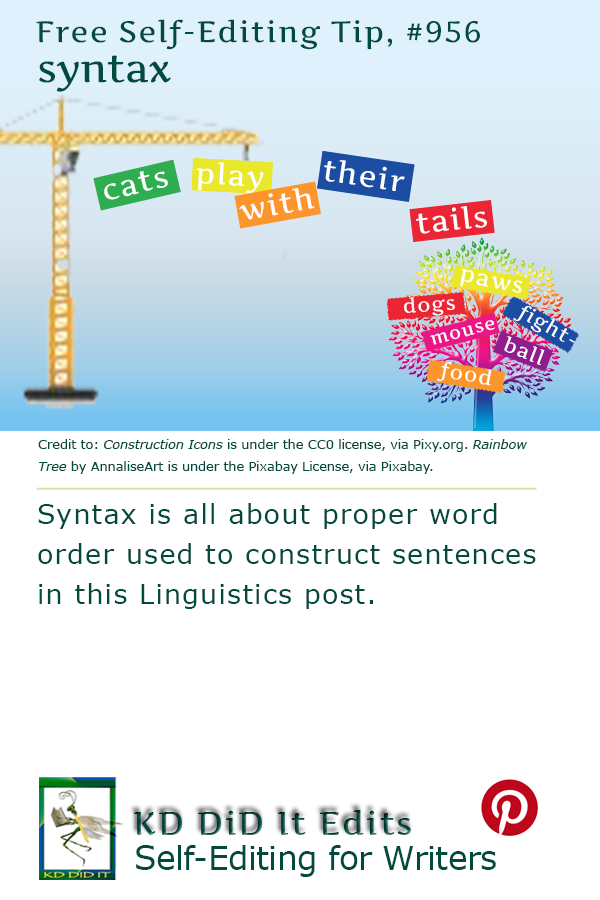Revised as of
18 Mar 2023
Syntax, a category in theoretical linguistics, explores the construction of language. What the “proper” word order is and how to create well-formed sentences.
My father-in-law once told me that you need to know the rules, so you know how to break them.
I can’t help but think that understanding syntax helps with creating dialogue and inventing your own language.
Other Posts on Theoretical Linguistics
Other posts on the primary theoretical categories can be explored:
- Intro to Theoretical Linguistics
- Generative – the theory that human language speakers have an idea of what the rules are and are able to learn in a short time with little effort
- Phonetics – the study of the physical production, acoustics, and hearing of speech sounds
- Phonology – the abstract study of the sound systems of languages in their cognitive aspects
- Pragmatics – the study of how language is used (in context)
- Semantics – the study of words and meanings
Linguistics is . . .
. . . the systematic study of the nature, structure, and variation of language (of which grammar is a part), which describes how people use language. For the writer, how words are used (or spelled!) determines a character’s social and educational level and the time period for the story.
As I discover more examples, also-known-ases, and additions, I’ll update this post. If you have a suggestion, I would appreciate you contacting me. If you found this post on “Theoretical Syntax” interesting, consider subscribing to KD Did It, if you’d like to track this post for future updates.
| Syntax | |||||||||||
| Part of Speech: Linguistics, Theoretical | |||||||||||
| Definition: How words and phrases are arranged in “proper” word order or to create well-formed sentences.
Grammar is the set of rules defining how to put together a phrase, clause, or sentence. As language evolves or is pertinent to individual groups, a different syntax may be employed: a social class, profession, age group, or ethnic group; teenagers’ slang with its more fluid word order and grammar; and, the technical vocabulary and manner of speaking by professionals, etc. You may want to explore “The Sentence” and “Subject-Predicate“. |
|||||||||||
| Rule: The principles for constructing sentences that: | |||||||||||
|
|||||||||||
| Syntactic Element | Definition: There are four parts of grammar that make up a clause:
Credit to: Boanerges |
||||||||||
| Subject | Definition: The subject initiates the action described by the verb. | ||||||||||
|
Return to top or post contents |
A syntactic element that can include: | ||||||||||
| Cars are expensive these days.
We are going to the movies. Reading is always a treat. The leftovers have gone bad. Where we go is none of your business. Sitting for hours without moving around is unhealthy. Legend:
|
|||||||||||
| Predicator | Definition: The verb/verb phrase that includes other elements that relate to the verb/verb phrase. | ||||||||||
|
Return to top or post contents |
We did not like the tone of that newsletter.
The dogs like eating those biscuits. The tenant will not leave her apartment for anything. The previous owner is being missed these days. Legend:
|
||||||||||
| Complement | Definition: A syntactic element that can include: | ||||||||||
|
Return to top or post contents |
There are three types of complements: | ||||||||||
| Pat read War and Peace.
Someone stole my package of printer ink. She cooked the salmon. That package looks heavy. Karen is sick. He loves eating. I adore fried plantain. We foolishly believed they cared. Legend:
|
|||||||||||
| Extensive Complement | Definition: Refers to an entity outside the sentence. | ||||||||||
|
Return to top or post contents |
The senator built a new house.
Papers were given to us for the exam. He bought five bottles of wine. Biscuits were served to us. Legend:
|
||||||||||
| Intensive Complement | Definition: Refers back to another element in the sentence, usually the subject or complement. | ||||||||||
|
Return to top or post contents |
The governor is shrewd.
The students elected him their captain. Kenny G is an accomplished saxophonist. We considered him suitable for the job. Legend:
|
||||||||||
| Double Complementation | Definition: More than one complement is in the sentence.
A.k.a. direct object, indirect object |
||||||||||
|
Return to top or post contents |
He bought his father a house.
They named him the champion. Santa Claus gave the children some presents. They decorated him a knight. We made him our leader. Legend:
|
||||||||||
| Adjunct | Definition: A type of adverb that modifies the word/phrase/clause but is not necessary to the clause.
You may want to explore the entry on adjunctive adverbs. |
||||||||||
|
Return to top or post contents |
Jenny helped Margaret this morning.
Yesterday, we distributed the newsletter. We distributed the newsletter throughout the building. We distributed the newsletter in the evening. We distributed the newsletter after we had dinner. Legend:
|
||||||||||
| Dependency Grammar (DG) | Definition: A directed link, i.e., every word(s) directly or indirectly connected to the verb.
Dependency grammars also allow sentence structure to be broken down into constituent parts. A directed link with a (finite) verb as the structural center of the clause structure (the head) with all the other words around it connected to the verb. Naturally, there are different types of dependencies:
NOTE: This is one of those modern categories Lucien Tesnière, a grammarian, invented. Dependencies are best suited for languages using a free word order, such as Czech, Slovak, and Warlpiri. A.k.a. dependency grammar, dependency tree |
||||||||||
| Constituent | Definition: A morpheme, word, phrase, or clause, creating a relationship between itself, the constituent, and the larger unit of which it is a part. | ||||||||||
|
Return to top or post contents |
When analyzing a sentence to identify the different parts of speech, you are parsing the sentence into its constituents.
Explore this further in the entry for phrase structure grammars in “Clause versus Phrase. You may also want to explore the entry in “Verb” on verb catenas. A.k.a. linguistic unit, relationship between words, syntactic unit Credit to: Crystal, 2008; Crystal, 2003; Nordquist |
||||||||||
| Examples of Immediate Constituent (ICS) Analysis | |||||||||||
|---|---|---|---|---|---|---|---|---|---|---|---|
| “The boy will sing.”
There are four word forms the, boy, will, and sing, each of which is a constituent. the and boy are closely related; will and sing are also closely related. This can be shown as [the boy] [will sing], equalling two constituent groups, i.e., ICUs. Credit to: Bache You can also look for the largest sequence of words that can be replaced by a single part of speech: a noun, a verb, an adjective, or an adverb. “Edward grows tomatoes as large as grapefruit.” Edward is a single noun as well as considered a noun phrase. grows is the main verb as well as considered a verb phrase. “grows tomatoes as large as grapefruit” is a verb phrase predicate. tomatoes could be a noun phrase, however, as large as grapefruit cannot be replaced by a single word and still supply information about the tomatoes. tomatoes as large as grapefruit could be a second noun phrase. Expansion is the technique of applying a substitution test to chosen constituents. Credit to: Klammer |
|||||||||||
|
|||||||||||
| Antecedent | Definition: An earlier clause, phrase, or word to which a pronoun, another word, or a noun refers.
Credit to: Simmons |
||||||||||
|
Return to top or post contents |
The train has lost its cattleguard.
John has lost his hat. I lost the marker in my book. George, whose hat is yellow, is lost. The Tupperware that is empty needs to be washed. The crowd crowed its excitement when the doors opened. Each of my boyfriends knows he has competition. Legend:
|
||||||||||
| Inflection | Definition: The way in which a word is changed — marking such distinctions as tense, case, person, comparatives, aspect, number, gender, mood, and voice — is changed or altered in form (usually the addition of endings) in order to achieve a new, specific meaning.
A.k.a. accidence, flection Credit to: Inflection |
||||||||||
|
Return to top or post contents |
cat, cats girl, girls, girl’s, girls’ I, you, we, they buy; he buys we walk, we walked I have called, I am calling big, bigger, biggest sing, sang, sung goose, geese |
||||||||||
| Tree Structure | Definition: A pictorial representation of the grammatical structure of a sentence made up of nodes and branches with nodes include a root node, a branch node, or a leaf node, a.k.a. parent nodes and child nodes.
A.k.a. concrete syntax tree, derivation tree, diagramming, parse tree, parsing tree, sentence diagram, syntactic tree diagram |
||||||||||

Syntax tree – Will I do my homework by Kayau under the CC BY-SA 4.0 license, via Wikimedia Commons. |
|||||||||||
C’mon, get it out of your system, bitch, whine, moan . . . which words are your pet peeves? Also, please note that I try to be as accurate as I can, but mistakes happen or I miss something. Email me if you find errors, so I can fix them . . . and we’ll all benefit!
Satisfy your curiosity about other Linguistics posts by exploring its homepage or more generally explore the index of self-editing posts. You may also want to explore Book Layout & Formatting Ideas, Formatting Tips, Grammar Explanations, the Properly Punctuated, Word Confusions, Writing Ideas and Resources, and Working Your Website.
Resources for Theoretical Syntax
Bache, Carl and Niels Davidsen-Nielsen. Mastering English. Walter De Gruyter, 1998.
Cassin, Barbara. Dictionary of Untranslatables: A Philosophical Lexicon. Princeton, 2014.
Chung, Sandy and Geoff Pullum. “Grammar.” Linguistic Society. n.d. Web. 23 March 2019. <https://www.linguisticsociety.org/resource/grammar>
Crystal, David. “Syntactic Unit (Concept).” Gold 2010. Gold Community. 2003: 99. 2010. Web. 15 Feb 2021. <http://linguistics-ontology.org/gold/2010/SyntacticUnit>.
Hale, Constance. Sin and Syntax: How to Craft Wickedly Effective Prose. New York: Three Rivers Press, 2001.
Klammer, Thomas P., Muriel R. Schulz, and Angela Della Volpe. Analyzing English Grammar. 4th Ed. Pearson, 2004.
Nordquist, Richard. “Constituent: Definition and Examples in Grammar: Getting to the Root of a Sentence or Phrase.” ThoughtCo. 23 July 2018. Web. 20 Feb 2021. <https://www.thoughtco.com/what-is-constituency-grammar-1689792>.
Simmons, Robin L. “The Antecedent: Recognize an antecedent when you find one.” n.d. Web. 21 Feb 2021. <http://www.chompchomp.com/terms/antecedent.htm>.
“Stanford Encyclopedia of Philosophy.” Stanford University. n.d. Web. 20 Feb 2021. <https://plato.stanford.edu>.
“What is Linguistics?” UC Santa Cruz. 4 Aug 2017. Web. 6 Dec 2020. <https://linguistics.ucsc.edu/about/what-is-linguistics.html>.
“What is Linguistics and Why Study It?” College of Social & Behavioral Sciences. University of Arizona. n.d. Web. 6 Dec 2020. <https://linguistics.arizona.edu/content/what-linguistics-and-why-study-it-0>.
“What is Phonology?” All About Linguistics. n.d. Web. 28 Dec 2020. <https://all-about-linguistics.group.shef.ac.uk/branches-of-linguistics/phonology/>.
Pinterest Photo Credits
Construction Icons is under the CC0 license, via Pixy.org. Only the yellow crane was used. Rainbow Tree by AnnaliseArt is under the Pixabay License, via Pixabay.


